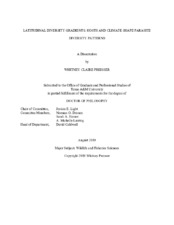| dc.description.abstract | The latitudinal diversity gradient (LDG), or the trend of higher species richness at lower latitudes, has been well documented in multiple groups of free-living organisms. Investigations of the LDG in parasitic organisms are comparatively scarce. Here, I investigated latitudinal patterns of parasite diversity by reviewing published studies and by conducting novel investigations of the LDG of parasitic helminths (nematodes, trematodes and cestodes) of cricetid rodents (Rodentia: Cricetidae). Using published host-parasite records from 175 parasite communities and field-collected data from 294 rodent hosts, I tested for the presence and direction of a latitudinal pattern of total helminth richness, as well as latitudinal patterns of nematode, cestode, and trematode richness. Additionally, I explored climate- and host-associated variables as potential correlates of parasite richness. The analyses were performed with and without phylogenetic comparative methods, as necessary. Across both studies and all levels of community organization, all helminths and nematodes followed the traditional LDG of increasing species richness with decreasing latitude, while trematodes showed no relationship with latitude. Cestodes exhibited both a reverse LDG and no latitudinal pattern, depending on the study. Across both studies, helminth and nematode richness were higher in areas with higher mean annual temperatures, annual precipitation, and annual precipitation ranges, and lower annual temperature ranges, characteristics that often typify lower latitudes.
Cestode richness was higher in areas of lower mean annual temperatures, annual precipitation, and annual precipitation ranges, and higher annual temperature ranges, while trematode richness showed no relationship with climate. Host diet was significantly correlated with cestode and trematode species richness, while host body mass was significantly correlated with helminth, nematode, and cestode species richness. Helminth β-diversity was high between and within most communities and was primarily driven by species turnover. Geographic distance, climate, and host β-diversity may predict patterns of helminth turnover in this system. Changes in helminth community composition and rates of turnover may contribute to the detected latitudinal patterns. Results of this study support a complex association between parasite richness and latitude, and indicate that researchers should carefully consider a variety of factors when trying to understand diversity gradients in parasitic organisms. | en |


